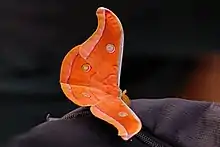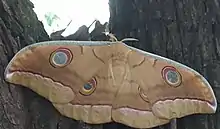Antheraea mylitta
Antheraea mylitta is a species of moth in the family Saturniidae known commonly as the tasar silkworm and vanya silkworm.[1] It is actually one of a number of tasar silkworms, species that produce Tussar silk, a kind of wild silk that is made from the products of saturniid silkworms instead of the domesticated silkworm (Bombyx mori).[2] This species is native to India.[3]
.jpg.webp)


| Antheraea mylitta | |
|---|---|
.jpg.webp) | |
| Scientific classification | |
| Kingdom: | Animalia |
| Phylum: | Arthropoda |
| Class: | Insecta |
| Order: | Lepidoptera |
| Family: | Saturniidae |
| Genus: | Antheraea |
| Species: | A. mylitta |
| Binomial name | |
| Antheraea mylitta (Drury, 1773) | |
| Synonyms | |
| |
This species is variable, with at least 44 identified ecoraces, populations adapted to varied ecological conditions and food plants. Ten ecoraces are used for silk production and have been studied to obtain data about their life cycles and silk characteristics.[4][5] Some ecoraces are so well differentiated that they do not interbreed in nature, though they are not genetically distinct and can be bred in captivity.[3]
This species feeds mainly on Terminalia trees and on Shorea robusta. It also eats many other kinds of plants, with various ecoraces specializing on certain taxa.[3] Other plants appearing in its diet include Indian jujube (Ziziphus mauritiana), axlewood (Anogeissus latifolia), jambul (Syzygium cumini), kumbi (Careya arborea), anjan (Hardwickia binata),[2] and species of teak (Tectona spp.) and crepe myrtle (Lagerstroemia spp.).
Tussar silk from this and related species of wild silkworms is a different color from domesticated silkworm silk, and it is coarser and stronger, making it more favorable in some applications.[3]
Like the domesticated silkworm, this species is susceptible to pébrine, a disease caused by microsporidian fungi in the genus Nosema. It is lethal to the larvae.[6] It is also commonly infected with the Antheraea mylitta cytoplasmic polyhedrosis virus (AmCPV), a reovirus which has been reported to destroy around 20% of each silk crop by inducing diarrhea in the larvae, leading to a condition known as grasserie.[7] Natural enemies of this silkworm include the uzi fly (Blepharipa zebina), which is a parasitoid that uses the silkworm larvae as a food source for its maggots.[8]
Many ecoraces are threatened due to extensive deforestation and the collection of cocoons from wild populations.[9]
Subspecies
- Antheraea mylitta mylitta
- Antheraea mylitta buruensis Bouvier, 1928
- Antheraea mylitta ceramensis Bouvier, 1930
References
| Wikimedia Commons has media related to Antheraea mylitta. |
- Kavane, R. P. (2014). Syzygium cumini L. – A potential new host of tropical tasar silkworm, Antheraea mylitta Drury (Lepidoptera: Saturniidae). Journal of Entomology and Zoology Studies 2(1) 33-37.
- Jolly, M. S., Sen, S. K., and Das, M. G. (1976). Silk from the forest. Unasylva 28(114) 20-23.
- Chakraborty, S., et al. (2015). Genetic analysis of Indian tasar silkmoth (Antheraea mylitta) populations. Scientific Reports 5 15728.
- Saha, M., Mahendran, B., and Kundu, S. C. (2008). Development of random amplified polymorphic DNA markers for tropical tasar silkworm Antheraea mylitta. Journal of Economic Entomology 101(4), 1176-82.
- Hansda, G, et al. (2008). Ex-situ stabilization and utility prospects of Jata ecorace of tropical tasar silkworm Antheraea mylitta Drury. International Journal of Industrial Entomology 17(2) 169-172.
- Mishra, C. S. K., Nayak, B. K., and Dash, M. C. (1992). Larval mortality of Indian Tasar silkworm (Antheraea mylitta) (Saturniidae) due to pébrine infection. Journal of the Lepidopterists' Society 46(2), 106-109.
- Ghorai, S., et al. (2010). Molecular characterization of genome segment 2 encoding RNA dependent RNA polymerase of Antheraea mylitta cytoplasmic polyhedrosis virus. Virology 404(1), 21-31.
- Rath, S. S. and Sinha, B. R. (2005). Parasitization of fifth instar tasar silkworm, Antheraea mylitta, by the uzi fly, Blepharipa zebina; a host–parasitoid interaction and its effect on host’s nutritional parameters and parasitoid development. Journal of Invertebrate Pathology 1(88), 70-78.
- Reddy, R. M. (2010). Conservation need of tropical tasar silk insect, Antheraea mylitta Drury (Lepidoptera: Saturniidae) – Strategies and impact. Journal of Entomology 7(3), 152-159.